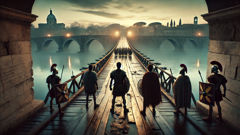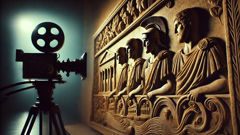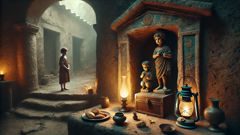Introduction
The banks of the Tiber remembered things the city could not afford to forget. Children who later learned the names of gods and consuls listened to their elders speak of a day when a handful of men stood between Rome and a tide of armed men, and when the timbers of a humble bridge seemed to hold the fate of an entire people. The bridge itself, made of trunks and planks and cunning fastenings, had a modest presence beneath the wide sky, stretching from the rough bank to the brighter promise of town. Above it, gulls wheeled and the river ran stubborn and dark, carrying away leaves, a tattered banner, a splinter from earlier skirmishes. Word moved through Rome like a current: the enemy had come from the north, numbers like a shadow, with banners that meant siege, and their officers had eyes like the glint on spearheads. It was not only the iron and the shields that made men tremble; it was the knowledge that if the bridge fell into an enemy's hand, the city would be stripped of one of its last lines of safety. So when three figures stood at the bridge's mouth, they were met with a mixture of awe and the dry, clinical relief that comes when a hopes rests on human shoulders. Horatius Cocles was one of those figures, and his name would be carried through streets and generations for the way he met a moment that could not be postponed. Beside him were Spurius Larcius and Titus Herminius, each a man with scars and quiet resolve, each having stepped forth because on that morning the city needed more than strategy, more than numbers. They needed courage translated into action, and they made the choice to become the hinge upon which history might turn. What followed was a stand that varnished the ordinary with a kind of legend: the smallness of a bridge turned epic, the steady eyes of a few turned into the city's bulwark. This is the tale of how they held, how the river and timbers and sky watched, and how the echo of a single night reached centuries to come.
The Stand on the Sublician Bridge
They made their stand on wood cut from common trees and lashed with rope and iron—simple materials arranged for a sake that had nothing simple about it. To look at the bridge was to understand the ingenuity and limits of early Roman engineering: it rose only a little above the water, its substructures driven into the river with the patience of men who respected both craft and chance. It had to be defended not by strength of stone but with the steadiness of arms and will. The first sounds that broke Rome's morning were not the clash of steel but the measured drum of distant feet. As the enemy column approached the bank, their standard-bearers stepped ahead like the reeds of some hostile marsh. Men whispered names of opponents—foreign kings, hired captains, mercenaries whose accents rattled like pebbles in a bag—and the mood on the bridge hardened into purpose. Horatius, Larcius and Herminius took their positions with a calm that confused the young volunteers beside them. Where fear might have contracted the throat, something like a slow resolve expanded in its place.

A single early volley of arrows and a scattering of thrown javelins announced the opening gambit. The defenders replied with disciplined thrusts, not theatrical charges; they held the narrow corridor that the bridge provided and concentrated their blows. The tactical truth of the Sublician Bridge was one the Romans embraced: a narrow crossing negates numbers. A hundred men can be stopped by a handful if the defense remains ordered. Yet tactics and geometry do not erase the physical hardship of standing shoulder to shoulder with no ground to fall back upon. Each defender felt the bite of wet wood beneath his sandals, the weight of a shield not just on an arm but also on an identity that might, in a single breath, be stripped away.
The enemy tried to rout them with weight and noise: a surge, a shove, a roll of men seeking to flood over the planks. Each attempt met a disciplined reply—spears angled to meet the press, blades that struck at ankles or wrists when a gap opened, a short, clinical series of maneuvers honed by centuries of warfare in the hills. Horatius's helmet was dented early in the fight; it did not leave his head. Blood walked down his cheek as if the river itself claimed him privately, but he fought on. Larcius was a man of quick hands and shorter temper, his strikes concentrated and accurate. Herminius moved like a shadow, slipping along the bridge's worn planks, intercepting men as they tried to wrench round to the edges. They formed a triangle of defense: Horatius at the center, the visible anchor; Larcius and Herminius, each a quieter but essential flank. They were not invincible—no mortal man is—but they were steady, and steadiness has a way of unmaking momentum.
As the day leaned away from noon, orders came from the city to sacrifice the bridge itself if necessary. Men set to work behind the defenders, severing the fastenings and preparing to remove critical planks, transforming the bridge from a route into a potential barrier of broken timber. It was a bitter calculus: destroy the path that sustained trade and memory to deny the enemy a deeper path into the city. Yet while engineers and conscripts made ropes sing and saws gnaw, the three defenders multiplied in myth. Observers later described Horatius as a man whose voice carried across the water, his shouts of encouragement and command binding the younger fighters like knots. A story worth retelling is shaped by small scenes: when a soldier's boot slipped, Herminius lunged and steadied him; when a youth wanted to flee, Larcius lifted his shield and held him in place. Those moments were the mortar of the day's heroism.
A turning point came when the engineers shouted that the last critical supports had been cut. Men on the Roman side began to retreat as the bridge's planks were loosened and the timbers were readied to be pushed into the current. At that instant, the choice that would mark memory was made. Horatius stepped forward and insisted, by quick gestures and terse commands, that he alone would remain to hold the bridge while the others fell back and the structure was severed behind them. It was not an impulsive act of vanity but a deliberate calculation. To hold a passage alone is a shape of courage that depends on focus rather than force: isolate the point of conflict and you concentrate resistance. Larcius and Herminius protested, their protests braided with the urgency of comrades who did not want to abandon a friend. Horatius's face, streaked with mud and blood, held the flatness of a man who had already measured the cost. With a final look to his companions and a short, wordless acknowledgment, he set his shield square and planted himself upon the planking.
The enemy surged anew, tasting victory as the bridge collapsed behind the Romans. Men came in waves, and the river took the timbers and sent them like a wake of splinters. Horatius stood as if the bridge were an extension of himself. Each thrust he parried with a familiarity that implied long practice; each parry was a conversation with death, and the words were iron. His breath rose in a cadence that matched the river's own, and those who watched later said they could hear the creak of the ropes as clearly as a lament. The defenders fighting to retreat felt the weight of his resistance. Bridges are, in some sense, metaphors: they connect, they allow passage, they are the places where choices are made visible. At the Sublician Bridge, the choice was to turn a passage into protection. The timbers came away in the river, splintering and shining; men tumbled, and a cry rose from the crowd on the Roman bank as if the city itself exhaled. The enemy's attempt to cross ended in confusion, and where confusion takes root, opportunity follows. Horatius had not defeated an entire army by himself, but he had made their numbers impotent in a place that demanded order, and in doing so he had given Rome the breathing room to survive.
When the immediate danger passed and the last hostile silhouette vanished into the distance, the city poured its gratitude and its questions onto the shore. How to measure such a deed? In laurels and coin, perhaps; in songs and in the soft mutter of women at the market, certainly; and in law, where deeds of civic valor are weighed and rewarded. Horatius would walk into those measures with a limp and a wound on his arm and a face that betrayed too much experience for anyone to call him young again. The three of them—Horatius, Larcius, and Herminius—did not return as triumphant figures who had sought glory; they returned as men who had done what duty required, whose faces held the memory of close danger and whose bodies carried its marks. Rome needed to turn that immediate, particular courage into something more lasting: civic myth. To do so was not merely to flatter the living but to stitch a moral into the city’s fabric so neighbors could see, in story, what it meant to stand when the hour demanded. The Sublician Bridge, a modest span over the Tiber, thus became a focusing lens for what Romans wanted to believe about themselves—unyielding, inventive, willing to give more than comfort to preserve the commonwealth.
There is a final, simpler truth that endures from that day: courage is seldom the spectacle sung at the moment it is given. It is a series of small memorials—an arm that steadies a falling friend, the choice to hold ground that could be surrendered, the whispered orders that stick to the air and change the shape of events. The three who defended the bridge did not all live to tell the story in its fullness; the river took its toll, and time took its own. But stories are the second current that the Tiber could not claim, and Rome made use of them with the same ingenuity applied to engineering. In the telling, Horatius became both a man and a symbol, and the bridge a place where citizens learned that the will of a few could determine the fate of many.
Aftermath and Legacy
The story that grows from a day of clash and plank depends on how people choose to remember small truths. In the days after the defense, markets hummed again and the river resumed its patient commerce. Children who had clutched parents during the alarm now peered along the bank to see marks of combat: a splintered beam, a discarded helmet, a scarred oar. The men who had been left to hold the gap returned to a city that wanted to name them and make them monuments. Horatius, having stepped ashore with wood underfoot and wounds staining his linen, stood before a public whose gratitude was heavy enough to shape law and reward. Yet Rome, in its mixture of practical governance and reverent ceremony, also required an accounting. Some leaders worried that transforming a single act into legend could create an appetite for dangerous imitation; others insisted that citizens should be shown an ideal to emulate. The city resolved this by honoring the defenders without requiring that every citizen risk life as a theatre of glory. The result was a balance between admiration and civic prudence that ancient Rome would repeat whenever a hero's deed needed to be translated into civic cohesion.

Longer-term, Horatius's stand came to mean different things at different tables. A farmer in a hill village far from the Tiber might hear the story as a caution and an inspiration, proof that a small number could protect what was dear. A general, studying the geometry of battle, saw tactical lessons in the way the bridge turned a numerical advantage into a liability. Poets and rhetoricians seized on the human details—the stubborn set of a jaw, the sound of a shield striking a spear—and wove them into verse and oration. The bridge itself became a touchstone in Rome's public imagination. Sculptors carved the names of the defenders in stone reliefs; a magistrate commissioned coins that showed a planked arch over a stylized river; children learned of the day in catechisms of civic virtue; the phrase 'to hold the bridge' entered the lexicon as shorthand for sacrifice in service of the whole. Memory is an active craft: people choose which angles to keep and which to smooth, and in doing so they create a heritage. Horatius's story proved adaptable because it offered both a visceral moment of tension and a moral that a city could teach its young.
Beyond symbols and public orders, the human consequences of that day were quieter and, in some ways, more permanent. Men and women who had seen the defense for themselves carried its imprint into their households. A widow might speak of a son who returned from the river dusty and shaken, insisting on nothing more than the simple courage of living. An old soldier, who had once stood with a shield that was dented in the same way Horatius's had been, might share a private joke with a younger recruit about what it means to be brave without being foolish. These domestic retellings tempered the public pageantry and kept the legend anchored in lived reality. There is a subtlety in the way personal memory and public narrative weave: the mythic version grants pattern and meaning to a community, while the private recollection preserves the sharpness of cost.
In centuries that followed, the figure of Horatius was summoned in times of trial. Governors urged stubborn defenders to emulate his steadiness; orators invoked him when speech needed muscle; artists retold his image in frescoes and mosaics. The physical bridge would not remain forever—wood warps, and rivers remold their banks—but the metaphor endured. Italy itself, with its patchwork of city-states and shifting borders, took comfort in stories that suggested a single point of honor could change larger threats. The Sublician defense became an early chapter in a long conversation about what binds societies together: law and common space, yes, but also stories about those who will stand at risk to preserve those things. The tale is not an argument against nuanced thought; rather, it is a reminder that certain moments demand a kind of human clarity that reasoning alone cannot muster. When a man plants his shield and refuses to fall back, others see a possibility for order where once there was only panic.
For Horatius personally, life carried on with both reward and quiet consequence. He received honors and a public reckoning that kept him in civic memory. He also lived with the physical and emotional residue of a day of concentrated peril. Old wounds ache when storms come, and the mind returns to places where time was measured by the scrape of iron, the creak of rope, and the smell of river-spray mingled with sweat. Yet there was also comfort in knowing his stand was not in vain. The city had been spared a deeper, longer violence; its markets could reorder and its children could go past the old bridge site to fish in the Tiber. That practical recovery is an essential part of the story. A city's survival is not only measured by the dramatic moment of defense but by the mundane acts that follow: rebuilding, reconciling, and integrating the memory of loss and courage into daily life.
Across the long arc of history, Horatius's stand at the Sublician Bridge remained a parable of clarity under pressure. It taught successive generations that courage is not only a fierce rush to glory but also a quiet decision to hold steady for the sake of others. It also taught a subtler lesson about how communities transform particular acts into enduring principles: by choosing which details to praise, which to record, and which to stitch into law, they shape their own future conduct. The Tiber runs on, indifferent to praise and oblivious to praise's absence, yet its banks hold stones that remember. The story of one man and his two companions at a narrow crossing became more than an anecdote; it became a living instruction in how a people might answer crisis. That is the most practical kind of immortality: to live on not only in bronze and coin, but in how a society decides, again and again, to stand when the hour calls them to do so.
Conclusion
Legends like the tale of Horatius at the Sublician Bridge endure because they do more than recount events: they teach a community how to inhabit courage and responsibility. Whether one reads the story as a literal retelling of a single night's events or as a metaphor for civic duty, the core remains resonant. A few determined people can change the shape of a crisis when they understand the geometry of choices and the ethics of sacrifice. The bridge, its timbers lost to the river long ago, still returns in the city's language and in the way parents ask their children to be brave—not for spectacle but for service. Rome needed a story that bound its people together, and the image of Horatius with his shield held firm provided a concise, stubborn instruction in what it meant to be Roman in times of threat. Across centuries, leaders and commoners both turned to that image to find steadiness in uncertain hours, making the legend not an artifact of the past but a living tool in the present. The Tiber keeps flowing, indifferent, but the memory of those who stood on its bridge carries on; such memories temper fear and teach the harder courage of staying when everything asks you to flee.













